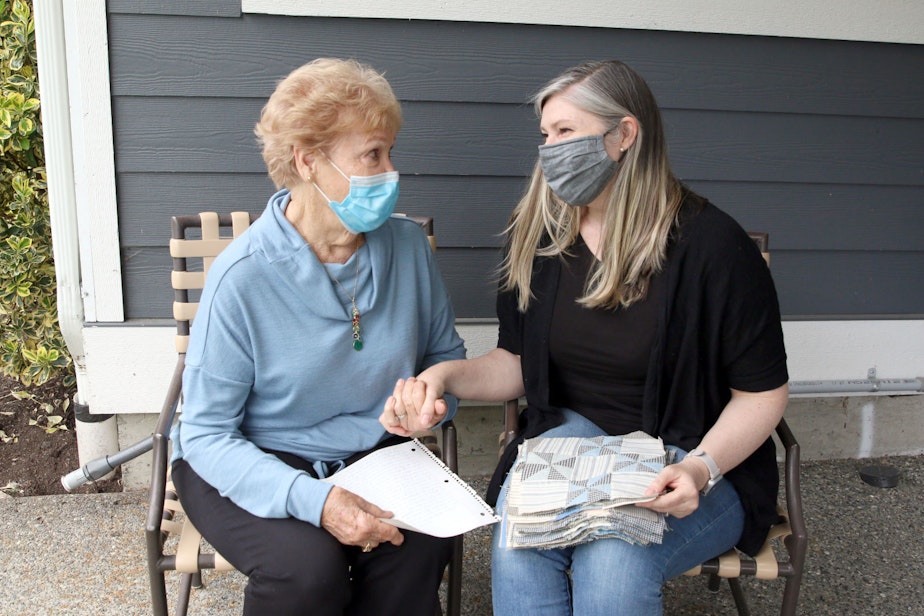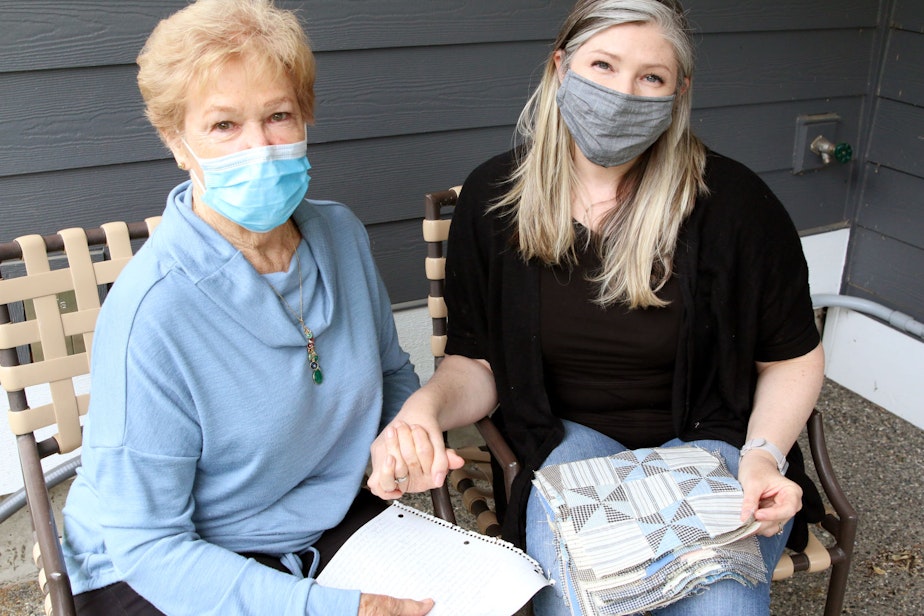This quilt was left unfinished during the 1918 pandemic. Now, these women will finish it

Betty Jones is 80 years old and lives in Edmonds. Recently, she was looking around at some old stuff she had, and she found a box. Inside, she found a stack of neatly sewn fabric squares, and a letter written to one of her distant relatives by her great, great aunt.
The letter was dated October 12, 1918.
It began, “My dear granddaughter, I have today started a small package of pieces for your quilt. I didn't get it set together as I intended, but concluded to send it anyhow, for fear it would be neglected. It would be pretty set together with light or medium colored calico, or percale, and quilted. If you can get it done, it would be pretty.”
The fabric with the letter had been saved to make a quilt. But the quilting project was interrupted by a global pandemic.
The letter continues: “Quite an excitement in the city about Spanish influenza. Schools and churches, theaters and everything that way closed."

Sponsored
The flu pandemic wasn't the only thing. The US was also fighting in World War I.
The letter concludes: “I know the suspense and anxiety is hard to bear for I have been there, but hope and trust and be brave. With love and best wishes from your Grandma Garvin.”
The letter was passed down to Jones, along with the unfinished quilting squares.
Now we’re in a pandemic of our own.
Jones and her daughter, Elizabeth Burns, have decided the time has come to complete the quilt.
Sponsored
BETTY JONES: If I had read this letter before the pandemic, I would not have thought that much about it, because it’s just 1918. It just didn’t click. It wouldn’t have meaning like it does now, knowing that this was done at a time that’s very similar to now.
In the days when these pieces are put together, fabric was not readily available like it is today. And so that's why they used things like their aprons or their dresses or shirts or that were maybe worn, but they would cut pieces out of them and make these quilts. And I can see where some of these [quilting squares] probably were aprons and dresses.
And this was also during the war, First World War, and things were not in, you know, ample supply. And so that's probably another reason they used aprons, and dresses and shirts.

ELIZABETH BURNS: Looking at this fabric, it tells a story — that everything is utilized. Nothing goes to waste. And that’s very different from what our society is now. We’re used to instant gratification, and everything prepackaged and sent to our doorstep.
Sponsored
BETTY JONES: ... and disposable.
ELIZABETH BURNS: And disposable. And back then, in a pandemic, that was not the case. You had to really be careful with, you know, what you used and plan ahead. And I think that’s part of quilting. Is taking pieces and rearranging it and putting it together as something new.
BETTY JONES: you know, people in those days didn't have the ability to get around like we do. I mean, there's still horses and buggies. And yeah, and if they lived out way from town, I mean, they didn't get into town very often. And if they did, that was a real exciting time to go to town. And people weren't as dependent on entertainment in those days. And so there was a lot to do, busy work doing this and enjoying doing things like this.
ELIZABETH BURNS: It's amazing that we've kind of gone back to that, making bread during this pandemic, and learning how to garden and you know, and to cook and to make things again, I, you know, we reverted back to that.
BETTY JONES: And it's been fun!
Sponsored
ELIZABETH BURNS: It's been fun! It's been great.
BETTY JONES: Well, it excites me that both my daughters that are here are interested in this because it kind of helps us to bond together and to see them interested and excited about it excites me.
Sponsored
ELIZABETH BURNS: I mean, I always loved spending time with you. And we always have such a fun experience. And regardless of what we're doing... it could just be driving in the car... but we've missed out on that during the pandemic. We haven't been able to see each other as much as we would like.
So I'm excited to work on this with you and for us to build those memories together.
This story was part of KUOW's series Voices of the Pandemic. It features music by Analog Heart. The Voices of the Pandemic theme song is by Alec Cowan. Reporter Joshua McNichols produced this story.





